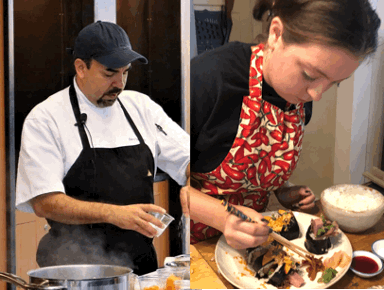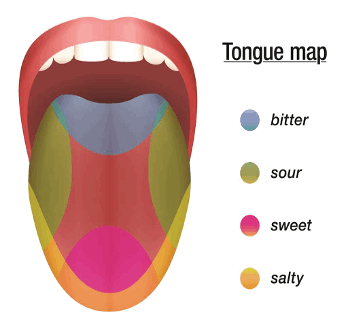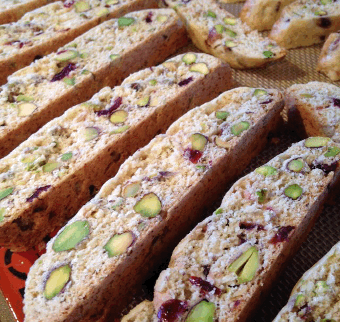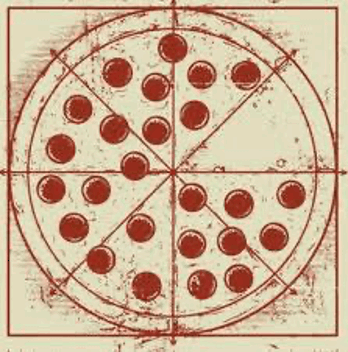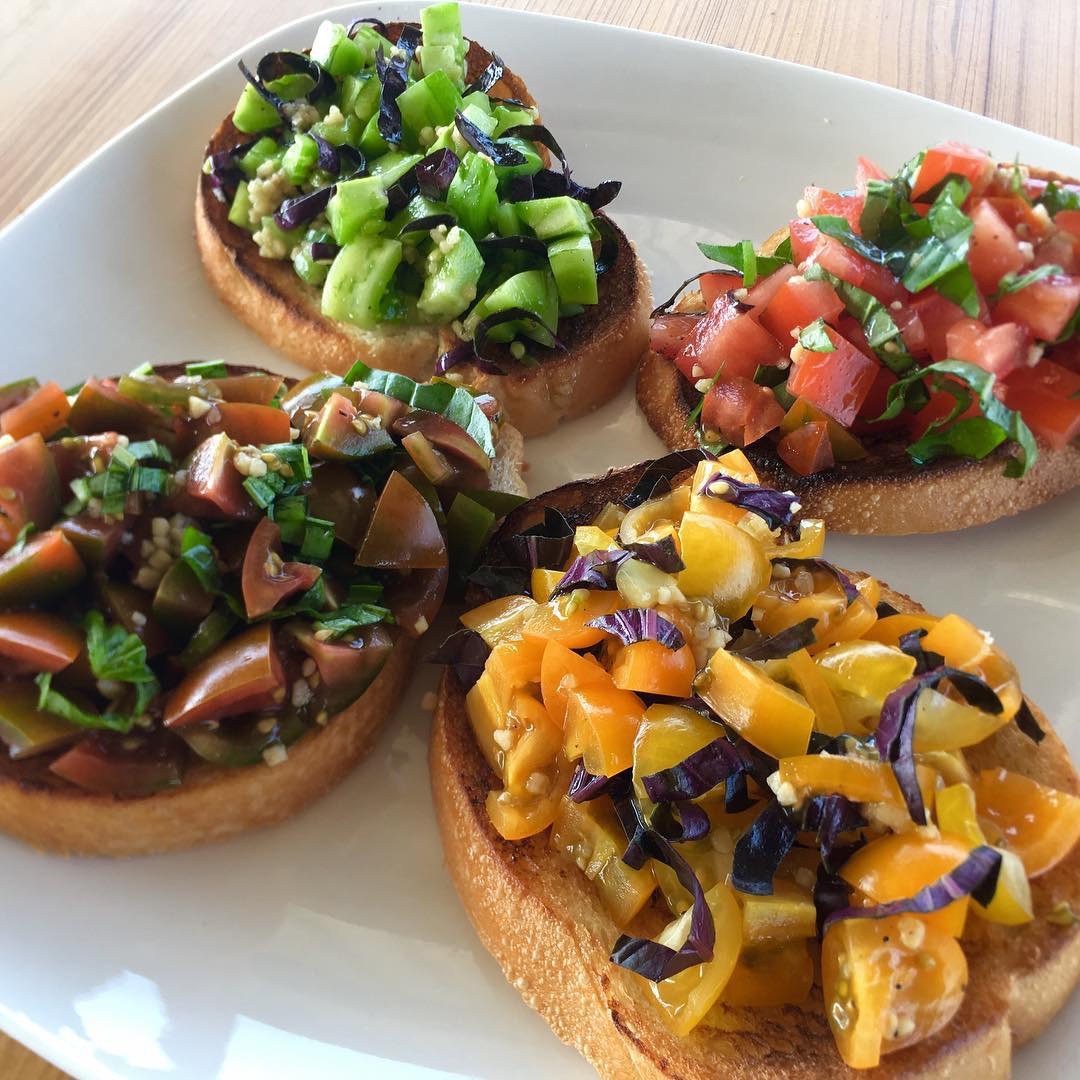
Cookin’ Smart in the Foodie Classroom with Dave Terrazas
Today’s challenges are changing the way we live, but they are also creating unique opportunities for learning, especially from the comfort of home. Even better, because parents are working from home more, kids may have an opportunity to learn alongside them! Food home delivery services and home gardens have become popular, which makes getting access to fresh, colorful, healthy and vibrant fruits and veggies easier than ever. Through these Foodie Classroom activities, we will dig into some healthy and delicious recipes while learning math and science concepts along the way.
We’ll be linking to these recipes:
Taste Bud Exercise and Bruschetta Recipe
Pizza Dough and Margherita Pizza Recipes
For more ideas about summer experiences you can do while learning at home with your kids, visit the main page, Charter a Summer of Learning.
Flavor Activity for Preschoolers (and Up)
Everybody says we eat with our eyes—okay, and our noses—first. But let’s not forget about our amazing taste buds! Did you know that the average tongue has between 2,000 and 8,000 taste buds? Taste buds regenerate often, but each one only lives about ten days. And where those taste buds are on your tongue determines how receptive they are to certain types of taste experiences.
Lesson 1: Foodie Classroom Flavor Test
Note—this recipe does require cutting produce with a knife. For preschoolers, parents or guardians should prepare all the ingredients ahead of time. The recipe, including a list of ingredients, can be found here.
Let’s start with a lesson focusing on the five basic sensory experiences of “taste”: sweet, sour, salty, bitter, and umami. Umami is often described as a “meaty” flavor experience, and is a sensitivity to the amino acid glutamine after certain processes convert it into glutamate. Note that “spicy” is not one of the flavor experiences, because it is perceived more like a touch sensation by a different set of receptors. A pepper can be sweet and not spicy, but it can also be both sweet AND spicy.
For this lesson, have your child do a simple taste test of the following ingredients individually to get a feel for the different types of taste:
Strawberries—sweet
Sea salt—salty
Lemon juice—sour
Cocoa powder—bitter
Cheese—umami
(If a child is allergic to the strawberries, substitute another sweet fruit, such as apple or banana.)
Interestingly, in the Western Hemisphere we tend to not favor bitter foods, such as the alkaline bitterness of cocoa. But, chefs generally build recipes by combining these flavor experiences, including bitterness, into new experiences. To observe this, dip a strawberry (or your alternate sweet fruit) in the cocoa and then taste it to observe any changes in the perception of cocoa. By introducing sweetness, sourness, and the flavor of the fruit, the whole perception of the cocoa changes to a pleasant one. The ratio or proportion of these flavor experiences also makes a difference. For example, semisweet chocolate contains more sugar than bittersweet chocolate, and so we perceive it to be sweeter.
Now, it also becomes clear that there are more than just five flavor experiences, because we can taste cocoa, which is different than the flavor of strawberry, which is different than lemon. We can also smell the differences. That is because all foods contain molecules called volatile organic compounds (VOCs) that we can smell and taste. Many foods contain thousands of these compounds in different amounts. These combinations create the different flavors and aromas we perceive in food. Try smelling each of the five basic samples to observe the unique qualities of each.
Lesson 2: Combine Flavors to Make Bruschetta
Next, let’s try a delicious and easy bruschetta recipe with tomatoes, basil, lemon, olive oil, and balsamic vinegar. It is such an easy recipe that is delicious because we mix all five of the basic flavor experiences, and enjoy the unique flavors and aromas of each ingredient. BUT—what happens when we change one or two ingredients?
You can find the recipe for bruschetta here.
Now, if you want to have some fun, create a second batch of the bruschetta recipe, but this time replace the tomatoes with peaches, and omit the garlic, and observe how the experience changes. When you think about it, tomatoes and peaches are both sweet and tangy (slightly sour). They are also both soft flesh fruits, so they kind of feel the same way when we eat them. They are both great in the recipe, but they are distinct because of the different VOCs each fruit contains. Tomatoes are also rich in the umami taste experience, but peaches are not.
Grade Schoolers Make Mixtures in the Foodie Classroom
You have to wonder if our amazing earth, with all of its beautiful components, was made with a recipe. Mountains are made of rock, and that rock often contains layers that can tell us quite a bit about the earth’s history, and you can even find fossils embedded in the rock. Mixtures are the next topic we tackle in the Foodie Classroom.
Lesson 1: Mix Up a Salad
We can understand how some of these layers and components like fossils are trapped in the rock by creating recipes that do similar things with ingredients! Let’s start with a recipe for a fun and summery peach, strawberry, mozzarella and greens salad served with a peachy vinaigrette. It’s a pretty healthy recipe that also teaches about the fun and value of “eating the rainbow”—colorful fruits and veggies. It will help to review the previous lesson about our amazing taste buds.
You can find the recipe for the salad here.
But for a quick review, our amazing taste buds can perceive five basic taste experiences—sweet, sour, salty, bitter, and umami. Our mouths and noses also have the abilities to perceive flavors and aromas, both of which come from molecules called volatile organic compounds (VOCs). Chefs love to create recipes that combine sweetness, saltiness and sourness, and vinaigrettes are great examples of recipes that include all five experiences, including the bitter and umami ones! The key to a good recipe, however, is balance. We never want too much saltiness, or too much sourness. Even too much sweetness can ruin a good recipe.
It is often taught that there are basically two types of vinaigrettes, French and American. French vinaigrettes tend to balance fat-based ingredients, like olive oil, with water-based ingredients, like vinegar, at a ratio of 1:1—or, if you look at it as a percentage, 50% to 50%. American vinaigrettes tend to double the fat-based ingredients, so that the ratio becomes 2:1, or 66% fat-based ingredients to 33% water-based.
You can find the recipe for the peachy vinaigrette here.
Now, to make the vinaigrette, start by combining the major fat-based and water-based ingredients together and observe what happens. These ingredients do not mix well, and when we add the rest of the recipe ingredients, we will observe that nothing really blends or mixes well, and we can see all of the individual ingredients. In science class, this is known as a “heterogenous” mixture. If the ingredients did mix well, to the point where the distribution became so uniform that we could not see individual ingredients very well, we would have created a “homogenous” mixture.
One unique ingredient that holds vinaigrettes together is mustard. Recipes often include Dijon mustard because it is absolutely delicious, and also because mustard seeds have a couple of proteins that are good at bonding to both fat-based and water-based molecules, just like olive oil and vinegar. These weak bonds mean that the ingredients will stay mixed together for a long time (though not forever), which makes for a very tasty vinaigrette. But there is more going on with that tasty vinaigrette. The other ingredients seem to be supported by the mustard protein bonding with the liquid ingredients. These bonds help heavier ingredients like garlic and shallot float throughout the vinaigrette. The bonds basically create a web that allows for these other ingredients to remain in a state of “suspension” through out the vinaigrette. This suspension is what truly allows all the ingredients to make it to our taste buds.
Lesson 2: Biscotti Suspension
Another fun way to observe suspension in the Foodie Classroom is by baking biscotti cookies with several large ingredients (chocolates chips, dried fruits, nuts, etc.). Biscotti is a twice-baked style of cookie, and when baked correctly the cookie “loaf” gets sliced into individual cookies in a way that lets you investigate suspension of ingredients, but this time through a process where proteins coagulate. Proteins can be found in flour (gluten), as well as in eggs (albumen). Coagulation happens when protein molecules attract each other and connect into a 3-D structure that looks a lot like web. In baking, heat makes these connections possible, and begins at around 140 degree Fahrenheit (140°F).
You can find the recipe for the biscotti here.
Note: I have taught similar lessons with grade school teachers looking for ways to help students learn about mixtures (homogenous vs. heterogenous). This helps children understand geology (soil layers and components of rocks), and the relationship between water and lipids. As such, this lesson can be adapted to help children understand preparing soil for gardening.
Big Kids Do Pizza Math in the Foodie Classrom
Pi and a pie—pizza is the perfect STEM lab!
Lesson 1: Bake a Pizza Pie (Pi?)
For upper school children, this two-part video lesson begins with a discussion of ratios and percentages, volume and weight, and making the perfect pizza dough recipe. Baking is based on chemistry, biology, and even physics, and algebra can help scale a recipe up or down. Baking is a very precise component of the culinary arts.
You can find the recipe for the pizza dough here.
What do you think would happen if we were not so precise with the ingredient measurements? What would happen if we accidentally put twice as much water in the recipe as it calls for? We would get a big mess! Baking results from many reactions taking place, and water is always involved in the recipe somewhere. The perfect amount of water helps the yeast wake up in a bread recipe, including pizza dough, and also allows the gluten protein in the flour absorb just enough water to get nice and stretchy. Too much water, and we won’t be able to keep the flour particles together.
Lesson 2: Using Pizza to Understand Pi
Now that we have a good dough, I’ll follow up with a Margherita pizza recipe that incorporates lessons on finding the radius (r), diameter (d), circumference (C) and area (A) of a circle . . . using the pizza . . . and using pi (π). Pi is the ratio of a circle’s circumference to its diameter, so to find π, we divide the circumference by the diameter. It is always the same so long as the object is a perfect circle, and is generally written as the numerical value 3.14.
So let’s say we rolled out the pizza dough into a perfect circle, and we knew based on the pan it was baked on (we’ll assume a circular pan) where the exact center point of the pizza pan, or circle, was. If we measure the distance from that center point to the edge of the pizza, that distance is the circle’s radius. Multiply that number times two (since the diameter is actually the sum of two radii (“radii” is the plural form of the word “radius”, meaning more than one radius) that measure the distance from one end of the circle to the center point, and the distance from the center point to the opposite end of the pizza. The formula looks like this:
d = 2r
Or:
If our pizza has radii that measure six inches, usually the length of a slice of a large pizza, the diameter for that pizza is 12 inches—exactly twice the length of the pizza’s radius.
d = 2(6) because our radius is 6 inches
As such,
d = 12
So how do we measure circumference of a circle, or the distance entirely around a circle from a single starting point? Well, lets say we have a perfectly round pizza that has a 12-inch diameter. Well, we have a formal for that using pi (π). That formula is:
C = πd
We know the values for π (3.14) and d (12), so:
C = 3.14 x 12
As such,
C = 37.68
Since we are measuring this distance in inches, our pizza pan (and our perfect pizza) is 37.68 inches all the way around the pizza from a single starting point.
Now, if we want to find the area of a circle, we have to use another formula:
A = πr2
What this means, is that we can calculate the area of our pizza by multiplying pi (π), or 3.14 by the square of the radius, and we already know that the radius of our pizza is 6 inches. A square is simply a number multiplied by itself. So the square of 6 (r2) is also written like this:
6 x 6 = 36
Now we can finish the equation:
A = πr2
Or
A = (3.14)(36)
Which equals
A = 113.04
And we say that the unit of measure for area, if we measured distance in inches, is in square inches. So, our pizza’s area measures 113.04 square inches.
Okay, great job following along! Now let’s actually bake a pizza!
You can find the recipe for the Margherita pizza here.
I hope you have had fun exploring these recipes, as well as math and science concepts, in the Foodie Classroom!
Local Connection: Foodie Classroom with Dave Terrazas
These activities are based on a program Chef Dave Terrazas created while serving as Chef and Campus Garden Manager for Allen Academy in College Station, Texas. The program combined Chef Dave’s kitchen and garden experience into teaching resources for the private school’s faculty, which was subsequently developed into the Culinary and Wellness Program at the San Antonio Botanical Garden, where Chef Dave served as Resident Chef and Program Manager. Chef Dave has since founded Foodie Classroom, a curriculum-based online platform designed for children, parents, caregivers and educators aimed at teaching math and science through the anatomy of food. Foodie Classroom, set to launch in the summer of 2020, will take participants on a virtual culinary learning adventure as Chef Dave visits with local area farms, gardens, parks, and kitchens to create innovative, video content that helps children learn in ways that they can understand. Everybody has a relationship with food; this series of video tutorials will empower children to develop culinary life skills, helping them to build their food literacy and confidence in the kitchen. Chef Dave will highlight like-minded community members to teach lessons on location in various parts of San Antonio, providing a familiar backdrop for kids to recognize and enjoy.
More Resources About Cooking and Education
The original Foodie Classroom blog was a way for Chef Dave to communicate menus and connected food service activities with curriculum to students, parents, and faculty at Allen Academy, where he served as Chef and Garden Manager:
Chef Dave discusses the power of food and its relationship with civil stability—“S.A.’s Freshest Chef,” Lindsey Carnett, San Antonio Express-News, September 14, 2017
The driver behind Chef Dave’s work stems from Allen’s “Theory of Food,” which posits that people develop a relationship with food by age seven: “Growing a ‘Theory of Food,'” John S. Allen, Psychology Today, October 6, 2014. This made Chef Dave begin to wonder if we could not only program a healthy relationship with food through children’s programming, but use food as a contextual component for understanding other elements of our world via STEM curriculum.
Charter Moms Chats
Watch Inga Cotton’s interview with Chef Dave Terrazas on Charter Moms Chats.
For more ideas about summer experiences you can do while learning at home with your kids, visit the main page, Charter a Summer of Learning. If your family enjoys cooking, try the Whis-Kid Guidebook activity; if you’re into gardening, look at Stay Green at Home.
Find all the recipes from this activity at these links:
Taste Bud Exercise and Bruschetta Recipe
Pizza Dough and Margherita Pizza Recipes
About the Author
Chef Dave Terrazas is the founder of Foodie Classroom. He is a Texas native, and formerly a defense and homeland security analyst researching precursors of social instability, including hunger and food insecurity. Cooking since he was a child, Dave’s global travels added to a growing interest in the culinary arts, culminating in the launch of a second career as a chef, horticulturalist, and food security activist. Dave holds degrees from American Military University, Wayland Baptist University, and Le Cordon Bleu. Beyond restaurant and institutional food service, Dave has been a private school chef and campus garden manager, a research associate at the Norman Borlaug Institute for International Agriculture at Texas A&M University supporting climate-based coffee resiliency research, the resident chef and Culinary and Wellness Program Manager of the San Antonio Botanical Garden, and a managing chef with Mercy Chefs, a humanitarian relief organization that provides food service immediately following emergencies and disasters. Dave is currently a partner of Edible San Antonio magazine, and is launching the magazine’s official podcast in July 2020. Dave also owns Foodie Classroom, an online learning resource that combines STEM standards of learning with agronomic, horticultural and culinary arts concepts, and uses farms, gardens, parks and kitchens as the classroom to create fun, immersive content for learning at home, or in the blended learning environment. Dave serves as education chair for the San Antonio chapter of the Texas Chefs Association (TCA), and additionally maintains a column in Edible San Antonio called Food for the Soul, where he provides a narrative of his work, and covers food security and local foodways-related topics. Dave also plays jazz.

